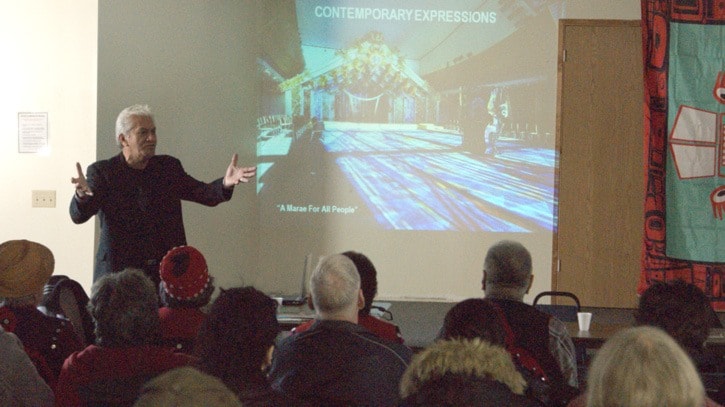The lower level of the Islander Hall was packed on the afternoon of February 22 to hear the project team discuss the opportunity for a Tsimshian cultural pavilion built on the waterfront, and it’s something that could become a reality sooner than later.
“This is doable by 2013. Cruise lines develop their plans two years in advance, and we need to be able to look two years ahead in our planning,” said Te Taru White, a consultant brought in to work with the project team, noting that the project is still very much in its infancy and still requires the concept design and business case to be developed.
“I’ve been asked already who is going to pay for this, how much it will cost and where the money is coming from. Those are all relevant questions, to be answered in the development of the business case…But I respond to those questions with a question of my own: How much is your culture worth and how much is it worth to showcase your culture to the world?”
Along with outlining projects he has been involved in in New Zealand, White highlighted statistics from the 2007 Prince Rupert Tourism Study that showed cultural experiences were top of mind for people who come to town and that a project like the cultural pavilion could go a long way to helping bring cruise back to Prince Rupert and economic development in the region.
“It may be that you don’t have enough product to offer, or maybe you’re not offering the product being sought…It is intelligent travelers that are coming to Prince Rupert, so give them intelligent product, not something that has been dumbed down,” he said, alluding to per-passenger spending that is lower in Prince Rupert than other cruise terminals. While there isn’t much known about the project yet, the partners are looking at a possible location on the waterfront directly beside Northland Cruise Terminal.
And while White outlined keys to a successful cultural pavilion, which include truthful exhibits, varied content and the inclusion of weavers, carvers and dance groups, he said not all cultural pavilions find success and pointed to the Lillooett pavilion and the Haida Heritage Centre – both of which have won awards for their programs and projects, but both of which are struggling to maintain their level of service in light of lower than expected numbers.
“I’m not saying don’t go down this road, I am sending a warning that they can be tough to sustain financially,” he said. “You need to be clear about the concept and purpose, which is what we are doing now…And you need to understand the balance between culture and commerce.”
Although the pavilion may not be ready until 2013 at least, the organizing committee, including representatives from Lax Kw’alaams , Metlakatla and the Prince Rupert Port Authority, are also planning some events that could help leave cruise passengers with a more positive impression of Prince Rupert in 2011. Among the option being looked at are having a storyteller on board, having First Nations Canoes accompany the ship into the harbour, having dance groups performing both in Mariner’s Park as the cruise ship pulls in and at the terminal as the passengers disembark and having weavers, carvers and artists working in the immediate vicinity of the terminal.
“Between now and May something has to happen,” said White.
“Something has to happen to send a message to the cruise lines that we are serious about keeping their business.”
